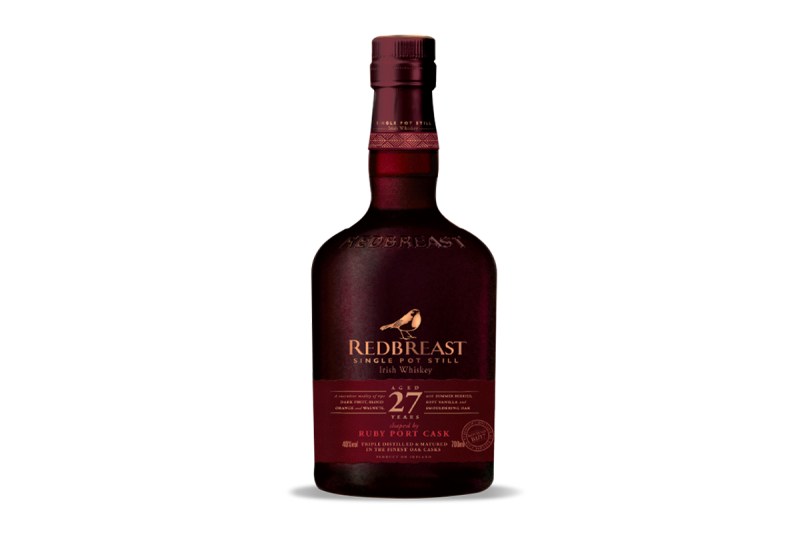Redbreast, one of Ireland’s most popular single pot still whiskeys, recently introduced the oldest expression in its core range, a 27-year-old whiskey matured in bourbon, port, and sherry casks. Master blender Billy Leighton and apprentice blender Dave McCabe were scheduled to travel to New York City earlier this month to launch the new expression, but those plans were disrupted, as was the entire world, by the coronavirus. Still, we were able to catch up with Leighton, an expert in all things Irish whiskey, over email to talk about this new release and the current state of Irish whiskey in general.

The Manual: How do you think Irish whiskey stands up to older age statements? Is it comparable to Scotch, or is the climate different enough to have a profound effect?
Billy Leighton: Take Redbreast 27 Year Old as the example. It compares very favorably to older age statement scotch. I wouldn’t necessarily put that down to climate, we are both relatively moderate when it comes to temperature extremes, but it does have a lot to do with maturation. Wood management is key, quality cask procurement gives us the confidence that we will be able to select casks which will produce best quality whiskey when the time comes.
TM: How long as the 27YO been in the works? At what point were you tasting casks to decide when the whiskey was ready?
BL: Redbreast 27 Year Old has been in the works for nearly three decades. For over 30 years, Dave and I, along with the team at Midleton, have been traveling to the Douro Valley in Portugal, where port has been produced for 2,000 years, to discover the finest caves in the region in a quest to provide drinkers with a truly unique taste experience. It is the foresight of our predecessors, who were procuring casks, such as Port, on a trial basis, that has allowed us to launch Redbreast 27 Year Old. So, even though the casks have been maturing whiskey for many years, and have been regularly sampled during that time, Redbreast 27 Year Old has final given them a permanent home.
TM: Can you talk about how long the port finish is?
BL: It’s actually not a Port finish — after sourcing ruby port casks, Dave and I filled them with pot still distillate before leaving them to mature, then combined them with whiskey aged in bourbon and sherry barrels (not a finish). The 27 Year Old process results in satisfyingly long balance of ripe fruit and wood spices, as the ruby port barrels impart fleshy fruit characteristics with notes of toasted oak which complements the rich and robust style of the distillate.
TM: Since this is now part of the permanent lineup, what is the stock like going forward? How many barrels are aging at Midleton in this age range?
BL: Given the complexity and length of the maturation process, Redbreast 27 Year Old is produced in limited quantities. We must bear in mind that Redbreast 27 Year Old is a product, along with others, which is produced at one single distillery in Midleton Co. Cork, and therefore a lot of planning goes in to the launch of such a product in order to guarantee a continued supply.
TM: Obviously, pot still has been a longstanding tradition in Irish whiskey. But it seems like there is a renewed interest as distilleries are releasing new single pot still expressions. Do you see this as a resurgence, and what part do you think Redbreast has played in this?
BL: As the standard-bearer of premium Single Pot Still Irish Whiskey, Redbreast has played a huge role in the resurgence of single pot still expressions. Redbreast continues to showcase why and how tradition and innovation continue to be of significance to whiskey aficionados and new whiskey drinkers alike. We continue to innovate and evolve our portfolio by bringing complexity and depth to the Redbreast collection, like with the addition of the 27 Year Old expression which not only celebrates our heritage, but pushes boundaries as well. Plus Redbreast is the most awarded Single Pot Still Irish Whiskey (the 12 Year Old awarded Worldwide Whiskey of 2019 at the IWSC), so it is a category which is very attractive for new producers to be part of. This can only be good for the whole Irish whiskey business.
Editors' Recommendations
- Mount Gay Rum’s Master Blender Unveils New Blends for 2022
- Jameson Cold Brew Is the New Limited Edition that Combines Whiskey and Coffee




